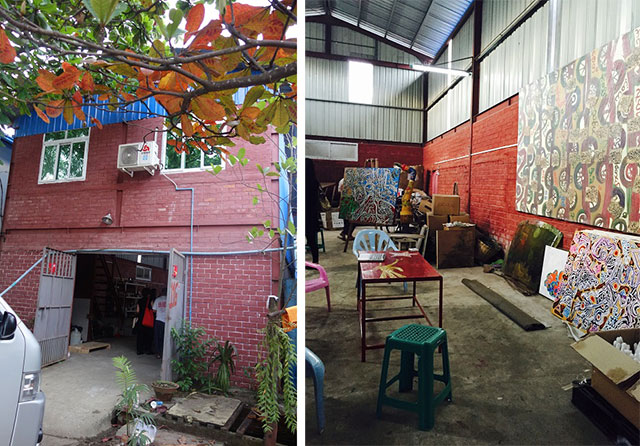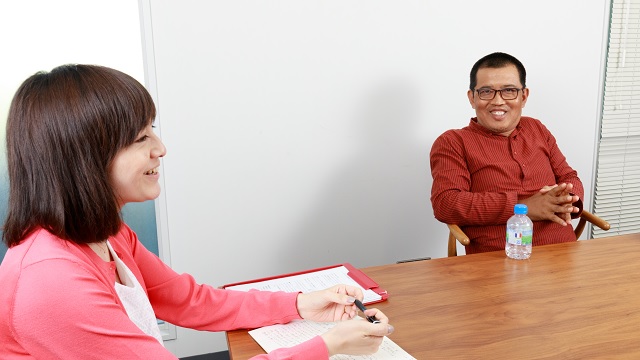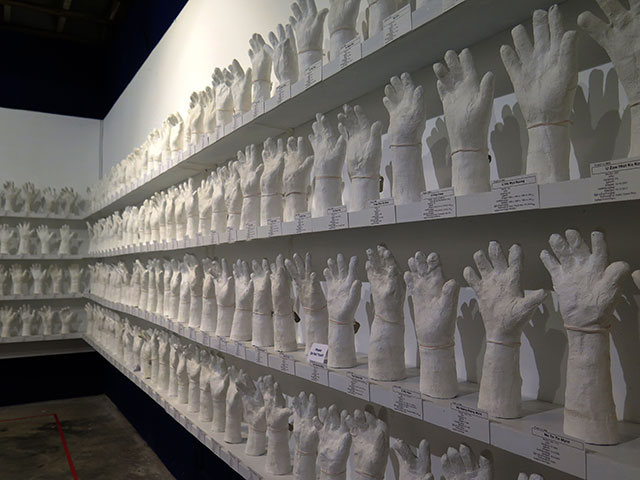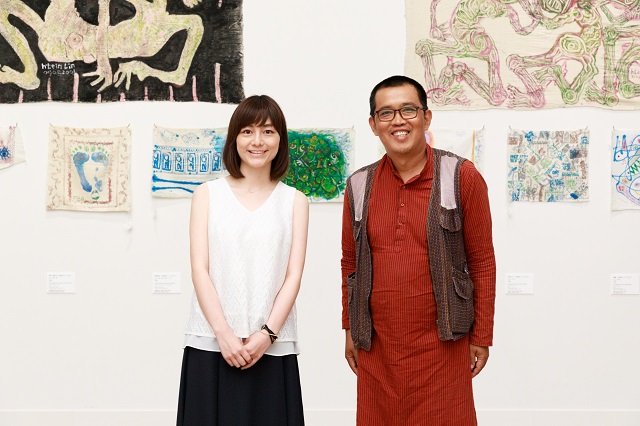The Aspirations and Setbacks of the Still Unknown "Democracy"
Kida: I have seen a photograph of you as a student standing on a stage as a comedian. Can you tell me about those early days in your career?
Htein Lin: In Burma, we have a form of comedy called anyeint ( a traditional Burmese theatrical performance where comic dialogues are performed during the intermissions), and that was how I used to appear on stage as a comedian. At the time, we had a socialist government under President Ne Win in power. When I was in university, the first generation of comedians was replaced by the second generation, and I was chosen as one of the second generation. Under the Ne Win administration, the country fell apart, and the citizens fell into poverty. I conveyed that fall through comedy.
Anyeint had also been the stage for the Myanmar independence movement and, even after that, it has always served as a very important opportunity to convey the political, economic, and social situations. Then in 1988, a student movement that went on to become the 8-8-88 Uprising arose, and I became one of the leaders of that movement.

As a leader I had to tell the citizens what the movement was doing and to call for reform. But on September 18th, 1988, the military staged a coup d'etat and took control of the government. I was still immature, so I thought it was necessary to fight for democracy through armed struggle. In Myanmar (then Burma), ever since I was born we had always had a single-party dictatorship, which meant I didn't understand the meaning of democracy at all. I went to the border area and joined the armed insurgents. At first, we were counting on support from the Indian government, but in reality we were unable to get any support at all, and ultimately I ended up moving into a refugee camp.
Kida: You mentioned you met Mandalay artist Sitt Nyein Aye in that refugee camp, am I right?
Htein Lin: Yes. Just like us, he had aspired to a revolution and come to the refugee camp. Even though we were living in the jungle, he held classes on how to draw pictures so that the students would not be wasting their time. But we didn't have enough materials, so we could only use two A4-size pieces of paper per day. For tools, all we had were pencils. We obviously didn't have other materials like canvases or other painting tools. Sitt Nyein Aye also gave classes on the history of art in the lecture hall. He taught us about famous artists like Van Gogh and Pablo Picasso, too, but we had no reference books, so we drew pictures using our own imaginations and just learned things that way.

Kida: It's interesting that your introduction to the great works in art history actually took place in your imagination. Instead of starting to produce things based on a knowledge of art history, for you, performances and plays using your own body and then the practical experience of drawing pictures using the materials you had on hand came first. What else happened at the refugee camp?
Htein Lin: After that, we joined up with another group of the All Burma Students' Democratic Front (ABSDF) who were armed and based at the Chinese border. That was the first time I had the real experience of armed fighting. But it was different from the lifestyle that people imagine in, say, Rambo, the 1982 American movie. We had to learn how to live in the jungle, how to find our way when we got lost, survival techniques when there's heavy rain for days, how to avoid dangerous insects and wild animals, et cetera. We had to master some hard-core survival skills, and we had to do our best to learn what to do if the government troops came after us in combat.
But after that, there was a split in our ABSDF camp, and one faction suspected the other of spying. There were instances of torture where they electrocuted people, water-boarded them, and burned them at the stake. As a result of the torture, some of my friends were paralyzed or became disabled and others were even killed after having their throats cut. I left the jungle and fled from the armed insurgent group. As I was running away, I was captured by the Chinese army, and in the end, I had to surrender to the Burmese military and relinquish my weapons. Then I was able to go back to university. And that's when I started to work on visual art.

Kida: After that, you entered the world of contemporary art. What were the circumstances leading up to that?
Htein Lin: The political activities I experienced beginning in 1988 were also underground activities, so there was a side to them that I could not talk about openly or publically in front of friends. Because of that, I thought conveying my experience and views in the form of art was the most appropriate method. Except that with visual art, it was hard because there was censorship. And comedy alone was not enough to articulate my ideas or argument. What I was doing was partly telling the history of the country, and partly telling what I experienced thus far, and doing it for future generations. This is definitely different from comedy in that it's not acting, but rather based on real-life experiences.
That's why I came to feel that contemporary art was the only way through which I could convey these things. So, that was the thought process which started my practice as a contemporary artist, indeed a first generation Myanmar contemporary artist. There were times back then when I was criticized and told, "This is not art." But I felt like using artistic methods and articulating my experiences has made me stronger.
The Unyielding Power of Expression in the Presence of Others
Kida: Even for those of us living in Japan who are detached from the harsh experiences of prison, looking at your works may make us aware of the unfamiliar, may rescue us, or even give us courage, I think. How do you feel about the fact that your drawings, which were produced in a completely different environment, are now displayed in a white cube in an art museum, being seen by all kinds of different people from around the world? In particular, how do you feel about them being displayed at this SUNSHOWER exhibition? What kind of message do you want to convey to the people who see your works in a completely different context?
Htein Lin: I think for about half a century, the people of Myanmar went through some really difficult times. In the case of Japan, there may not be difficult conditions in the sense of being under a military regime like Myanmar was a few years ago, but things like natural disasters and wars have brought all sorts of suffering here, too. I visited Hiroshima on this trip, and I saw the videos and photos at the Peace Memorial Museum of those who were killed by the atomic bomb. The people of Hiroshima survived that challenging time, and now Tokyo and also Hiroshima have grown into large cities. On the other hand, I often hear that the suicide rates in Japan are very high.
When you think about the mental side of Japanese people who have gone through and recovered from a war experience like the one in Hiroshima and a natural disaster like the one in Kobe, it actually seems odd to me that there are many who resort to suicide. What I want to stress is that the question is this: when you are put in a difficult situation like imprisonment, do you give up, or do you see it as an opportunity? That's a choice everyone has to make.

Even if it was not an extreme condition; even if, for instance, you make a mistake in your community, you have to overcome the suffering that it brings about. Some people quit when placed in that type of situation. Among inmates, too, there were some who fell into despair and became ill, then they became frail, and died. Some die from mental illness or depression. But according to Buddhist thought, people are provided with the ability to overcome suffering.
That is something that is given only to humans. So through the SUNSHOWER exhibition, I want to tell Japanese viewers, and also viewers from other countries, about the creativity and mental fortitude that each and every individual person has. I want them to know that even though I was put in harsh conditions, I got through it without giving up, and I created artworks like this.
Kida: The roles of contemporary art and how it contributes to society is now becoming important. This point is also being addressed in the SUNSHOWER exhibition in a section called "What is Art? Why Do It?" Finally, I'd like to ask for your ideas on how drawing and engaging in artistic practices can affect our lives. Also could you tell us about your recent activities and how they relate to current Myanmar society, and its ongoing democratization?
Htein Lin: As I've said already, when I made my paintings in prison, the cooperation of other people was essential. Making paintings helped foster a better mutual understanding with other inmates, and it was characterized by our sharing of secrets. I was also doing performances. In those instances we had to decide who would act as guards and where we would meet, et cetera. In prison, there were younger inmates who were students, and there were people who were serving time for other crimes, so I worked together with them. An artwork only comes about through the help of everyone. In that way, my art is linked with others, or, to take it a step further, with the community. And it reflects what is going on in this country and what the situation is like here.


Myanmar is moving toward democratization, but it is still in a transition period. For my art practice during this period, I am meeting with former political prisoners in locations such as Mandalay, Yangon, Taungoo, and Magway, and creating plaster casts of their hands. I collect not only the casts, but I also interview them in markets, parks, and schools, for example. I ask them questions like, "Why did you go to prison?" "What kind of experience did you have while in prison?" and "What kind of torture did you suffer?" I discover how they got through those harsh conditions and what their tricks and strategies were. So far I have collected around five hundred casts. In other words, I have been able to collect the stories of about five hundred people.
Kida: That's A Show of Hands (2013–), right? I think hands are an extremely symbolic motif. These hands not only connect people who once spent time in prison, but they also link them to the present; a time when they have been freed from that past in prison, and they pass along to the next generation the memories of those harsh experiences. Plus, the title A Show of Hands refers to "raising one's hand," an action that serves as a core element of democracy. You've said before that this work is built on relationships of mutual trust. I imagine the time spent interviewing them while you make the casts is also a component of the work?

Htein Lin: Exactly. Among the former political prisoners, there were some female students who were imprisoned at the age of fifteen or sixteen, and in some cases they were also tortured. Upon hearing their story, I learned that they had no feelings of fear at all, but rather withstood their torture with courage and, in some sense, even enjoyed succeeding in overcoming the situation they were placed in. They joked as they spoke about it, so I ended up laughing with them. I am very moved by their vitality in the midst of those harsh conditions. It's through these kinds of interviews—through the process of dialogue with them—that these works emerge and become.
Even with this interview with you now, there is a combination of personal experiences between you, the interpreter, and myself, and I think there is that kind of composition—a composite of experiences, as it were. It's also an intellectual conversation, too. We talk not only about art, but about the histories related to art. And it's not just each of our experiences, but also the kindness, good will, and considerations of the people who are present that emerge. Our maturity as human beings also comes into play. Going back to your earlier question about the effects of art in life, while there are my financial and academic aspects, considering the dialectical process I just described, I think what is most important for me, the other, and the community is for us to all deepen our maturity as human beings. I think that conviction is what is giving me the driving force to my art practices.

At the National Art Center, Tokyo, on July 14, 2017
More Information
- Htein Lin Official Website
- SUNSHOWER: Contemporary Art from Southeast Asia 1980s to Now Exhibition Official Website
- SEA Project Official Website
Interviewer: Sayuri Kida
Born in Kyoto, Japan. After working at a gallery in Tokyo, moved to Hong Kong to study the archives of Asian Art Archive at the Asian art, during which time she earned her MA (Cultural Studies) at the Chinese University of Hong Kong. Has also conducted research at the Indonesian Visual Art Archive (IVAA) in Jakarta. Joined the National Art Center, Tokyo in 2016, and worked on Htein Lin's artworks for the SUNSHOWER exhibition. Lives in Tokyo.
Interpretation: Maung Thein Htaik
Photo (Interview): Kenichi Sato







